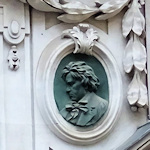
Vienna’s Schwarzspanierhaus enjoys a dark entry in the encyclopaedia of music history. This is the former location of the home of Ludwig van Beethoven, where he passed away in 1827.
- Original house no longer exists
- …demolished in the early 1900s
- A plaque and relief on the new building recall the importance of the site
- Book a concert experience* for Vienna
- See also:
The Schwarzspanierhaus

(The house Beethoven died in. 1903 photo from the Atelier Brand-Barozzi photo studio; Wien Museum Inv.-Nr. 28147/6; excerpt reproduced with permission under the terms of the CC0 licence)
Beethoven died on March 26th, 1827, in his apartment in a converted late-17th century convent building (the Schwarzspanierhaus) just outside the old city walls.
Two days later, the Wiener Zeitung newspaper opened their report with the simple words (my translation):
Ludwig van Beethoven died the day before yesterday, between 5am and 6am, after a long time on his sickbed with dropsy, in the 57th year of a life dedicated to the arts
They buried the great composer in the Währinger Cemetery before later moving his body to an honorary grave at Vienna’s Zentralfriedhof.

(An invitation to attend Beethoven’s funeral at 3pm on March 29th, 1827, published by Verlagsanstalt “Kunstgraphik”. The pictured card may be a reproduction of the original, though; Wien Museum Inv.-Nr. 188554/111; excerpt reproduced with permission under the terms of the CC0 licence)
The debate over the cause of death continues, but suffice to say Beethoven was not a well man; recent research suggests liver problems (possibly caused by a mix of a genetic predisposition to liver disease, a prior hepatitis B infection and alcohol).
Incidentally, that very same apartment later provided a home for another artistic genius, albeit one not quite in the same league as Beethoven: Nikolaus Lenau (1802-1850), a celebrated German-language poet.
The house today
So what can you still see of the house and final residence of dear Ludwig?
Not a lot, unfortunately.

(The house they built on the site)
The demolition crew turned up at the Schwarzspanierhaus in the early 1900s. So the building you see standing on the same site today is not the one that once housed Beethoven.
Hard to imagine that modern Vienna would allow such an act of historical vandalism (the decision to pull down and replace the house proved controversial even back then).
Fortunately, parts of Beethoven’s apartment landed in the city archives.
For example, the House of Music has the entrance door on display, and the flooring formed part of the Beethoven Moves exhibition at the Kunsthistorisches Museum.

(The memorial plaque at the location today)
The new building does, however, offer a couple of nods to its historic location:
- A plaque outside features a relief of Beethoven and the words (my translation):
The house that stood on this site until 1904 was once home to Ludwig van Beethoven, who died an edifying death here on March 26th, 1827. Erected with the agreement of the Abbey of Heiligenkreuz by the Rossauer Male Choral Association on November 3rd, 1929
- The unusually decorative entrance to the house has two portrait reliefs: one of Beethoven and one of Lenau:

(The house portal)
At the time of writing, the Weltcafé Wien occupied part of the building, and I’ve enjoyed a decent cappuccino and brunch inside. Seems kind of poignant to drink coffee there, given Beethoven’s love of the drink.
Walk around 5 minutes south and west of the Schwarzspanierhaus and you reach another Beethoven landmark at Alserstraße 17. His funeral service was held in the church there (the Alserkirche or Holy Trinity Church) on March 29th, 1827.
How to get to the house
Although beyond the city walls at the time of Beethoven’s death, the location is now quite central.
Subway: the Schottentor station (on the U2 line) is around eight minutes’ walk away (or catch the trams listed below).
Tram/bus: take the 43 or 44 trams to Landesgerichtsstraße or the 37, 38, 40, 41 or 42 trams to Schwarzspanierstraße. Both stops are the first stop after you leave Schottentor on any of these lines.
Address: Schwarzspanierstraße 15, 1090 Vienna